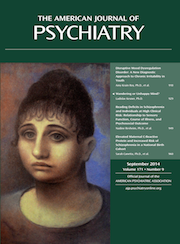Consider ECT for Treatment-Resistant Childhood Schizophrenia
To the Editor: We read with interest the clinical case conference titled “Management of Clozapine-Induced Fever in a Child,” by David I. Driver, M.D., et al., in the April 2014 issue of the Journal (1). The case highlighted an 11-year-old girl, diagnosed with schizophrenia, whose symptoms did not respond to various antipsychotics, antidepressants, clonazepam, melatonin, and a botanical preparation. As a “last resort,” she was treated with clozapine and developed a fever while receiving this medication. We are concerned that the report neglected to mention any consideration of ECT, for which there is a considerable evidence base in children. There are seven published studies from 1997 to 2012, including chart reviews, a controlled prospective case study, and a longitudinal follow-up of 272 children and adolescents with schizophrenia spectrum disorders treated with ECT (2). These studies show a beneficial response in 28%–58% of adolescents treated with ECT, often as an adjunct to antipsychotic medication. As with adults, the greatest efficacy was observed with positive, catatonic, and affective symptoms. ECT is shown to accelerate treatment response and reduce hospital length of stay among children with schizophrenia. The patient described in the report demonstrated delusions, aggression, labile affect, and disorganized thought, all of which would be expected to be ECT responsive.
1 : Management of clozapine-induced fever in a child. Am J Psychiatry 2014; 171:398–402Link, Google Scholar
2 : ECT for schizophrenia spectrum disorders, in Electroconvulsive Therapy in Children and Adolescents. Edited by Ghaziuddin NWalter G. Oxford, United Kingdom, Oxford University Press, 2013, pp 191–216Crossref, Google Scholar



